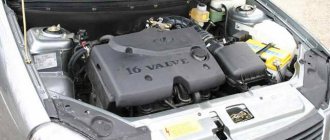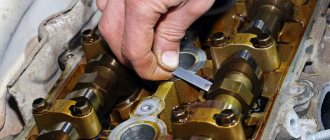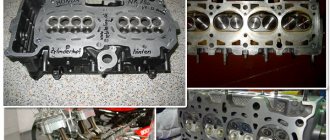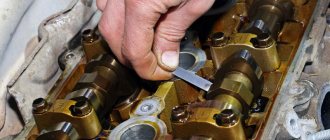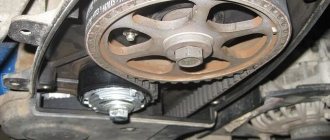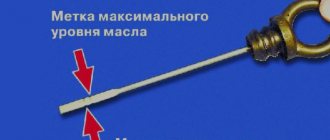Today you can find various types of internal combustion engines on cars, ranging from low-volume 3-cylinder units to powerful V8 or V12. At the same time, the vast majority of cars under the hood have conventional 4-cylinder engines.
If previously such power units were installed on entry-level and middle-class models, now the 4-cylinder engine can be seen even in the premium segment.
The fact is that boosting, increasing the number of valves per cylinder, introducing variable valve timing systems, installing turbocharging and other improvements made it possible to achieve the required power and efficient output from such engines.
The most affordable solution for increasing efficiency turned out to be a design that involves a greater number of valves per cylinder. In the simplest version, engines can have 2 valves (intake and exhaust). In more technologically advanced versions, the timing belt receives 4 or 5 valves.
In this article we will talk about the difference between an 8 valve and a 16 valve engine, as well as which engine is better, 8 or 16 valve. Next, we will try to figure out what advantages and disadvantages a larger or smaller number of valves in an engine has, taking into account the repair and maintenance of such internal combustion engines.
More modern 16 valve engine and 8 valve: the difference
To begin with, four-cylinder engines with 8 valves (two for each cylinder) are a long-standing, reliable and time-tested design. Today, some auto manufacturers are actively installing such engines in their budget versions of cars.
Also on a similar vehicle model you can find a more modern 16 valve engine. In other words, the buyer can independently choose a more suitable type of internal combustion engine. For a better understanding, it is necessary to understand what advantages and disadvantages one and the other design has.
Advantages of eight-valve engines
So, the version with 8 valves initially costs less and is usually installed on cars with the simplest configuration. This was done to reduce the cost as much as possible. Such an engine has one valve for each cylinder to admit the fuel-air mixture and one valve to release exhaust gases from the cylinder.
Structurally, the 8 valve engine has one camshaft. The timing drive can be realized either by installing a timing belt or using a chain. The main advantages of this design can be considered the simplicity and accessibility of repairs, as well as unpretentiousness to fuel quality and lower demands on the quality of engine oil.
It turns out that repair and maintenance of an engine with 8 valves is cheaper, which looks like an undeniable advantage for the owner of a budget car. If major repairs are necessary, an 8-valve engine usually requires fewer parts to be changed compared to more modern analogues.
- Engines of this type are well suited for harsh operating conditions (loaded conditions, low quality fuel and lubricants, polluted air), they are easier to maintain and repair.
- Regarding valve bending due to a broken timing belt/chain, most 8-valve units have a better chance of not being damaged compared to 16-valve versions.
- Also, engines with 2 valves per cylinder are smaller in size, they are easier to install in cars with small engine compartments, and access to attachments during repairs is less difficult. From this it follows that maintaining and repairing eight-valve internal combustion engines is not only cheaper, but also more convenient.
- Let us also add that these engines are better suited for installing gas equipment on them. The ease of implementation of the timing belt and the increased resource of this design allows units with 2 valves to operate normally on gas for quite a long time.
Disadvantages of 8 valve engines
However, the overall simplicity of the device also has its drawbacks. First of all, manufacturers pursue the goal of total savings during the manufacture of such internal combustion engines. This is manifested both in the quality of execution of individual elements and in the absence of some solutions to simplify maintenance.
For example, many engines with 8 valves require additional adjustment of valve clearances. This means that such an internal combustion engine does not have hydraulic compensators. On the one hand, this is a plus, since the requirements for oil quality are lowered, but it still becomes necessary to periodically adjust the clearances manually.
If we talk about the power of such engines, the total diameter of the holes for 2 valves will still be smaller compared to the diameter of 4. This means that the working mixture does not enter the combustion chamber so quickly, and the filling of the cylinder deteriorates.
After burning the fuel charge, exhaust gases are removed from the cylinders more slowly and less efficiently, that is, ventilation deteriorates. All this leads to the fact that such an engine has a slow response to pressing the gas pedal.
It turns out that internal combustion engines of this type are not suitable for active acceleration from the bottom, but they pull well at low speeds. Acceptable dynamics are achieved in the middle speed range, that is, the engine needs to be cranked. As a result, such units naturally consume more fuel. Some comments also arise in relation to comfort. Engines with 8 valves vibrate more, may operate less steadily, and are noisier.
Pros of 16 valve engines
The main advantage of such a motor is considered to be better output and more power with the same displacement. At the same time, fuel efficiency is achieved. The thing is that the intake and exhaust system on such units works more efficiently.
As we have already said, four valve holes have a larger total diameter compared to two. Thanks to this, more working fuel-air mixture can be supplied to the combustion chamber per unit time, and exhaust gases can be removed more efficiently.
As a result, the filling of the cylinders improves, the mixture flows more evenly, and combustion occurs more fully. Subsequent ventilation is also implemented at a better level. It turns out that thanks to these features, a 16-valve internal combustion engine is 15-25% more powerful than a similar 8-valve engine. At the same time, such an engine will be more economical.
- In parallel with this, the sixteen-valve engine has hydraulic compensators, which allows you to constantly maintain the specified thermal clearance of the valves in automatic mode.
- Thanks to the optimized charge combustion process in the cylinders, engines of this type are considered more responsive and elastic, pick up well from low speeds, and have a more even torque plateau.
Disadvantages of engines with 16 valves
First of all, the timing device in such units is more complex. At the same time, it is immediately worth highlighting the increased sensitivity to the quality of engine oil and fuel. Contamination of the lubrication system or working fluid leads to rapid failure of hydraulic compensators.
As for repair and maintenance, such a unit is more complex and expensive. The design involves not only hydraulic compensators, but also two camshafts (one for the intake valves, the other for the exhaust valves), as well as a larger number of valves.
Type of petrol intake system
Cars can have two types of intake systems - injection or carburetor. The electronic (injection) intake system allows for greater efficiency, which is why it is installed on most modern cars.
The carburetor system does not provide for atomized fuel in the combustion chamber, but rather a jet of fuel thrown into the gasoline system. At the same time, the car experiences a significant increase in fuel consumption, controllability deteriorates and engine performance is disrupted. Multi-carburetor systems are used quite rarely and are installed on tuned or sports vehicles.
Which power unit is better to choose?
If we summarize all the above features, then the following becomes clear:
- An engine with 8 valves is easier to maintain, cheaper to repair, works better on low-quality fuel and oil, and is well suited for installing gas equipment. At the same time, such an engine consumes more fuel, produces less power, is more vibration-loaded and noisier.
- A power unit with 16 valves allows for better dynamics, it is more powerful, consumes less fuel, and does not vibrate as much. In parallel with this, the requirements for the quality of fuel and lubricants are increasing, and the costs of maintenance and repairs are increasing.
We also recommend reading the article about what is better to choose, a gasoline or diesel engine. From this article you will learn about the advantages and disadvantages of these types of internal combustion engines.
If there is a choice between these two types of internal combustion engines, then individual preferences and features of subsequent operation should be separately taken into account. In cases where dynamics and efficiency are needed, and the car is planned to be serviced at a professional service station, then it is optimal to purchase a more technologically advanced 16 valve version.
If the issues of dynamics, power and fuel efficiency are not so important, and you plan to service the car yourself to save money or taking into account the inability to visit a service station, then an engine with 8 valves looks like a more suitable option.
Let us also add that today many engines with 8 valves are also equipped with hydraulic compensators. This means that the requirements for oil quality and its timely replacement for such internal combustion engines remain increased. Also, in most cases, when the timing belt or chain breaks on 8 valve units, the valve also bends.
It turns out that their main advantages remain a more affordable initial price of the car, less sensitivity to fuel and the composition of the fuel-air mixture, as well as ease of repair, especially with self-service.
124 VAZ engine
Type of gasoline injection system
The gasoline injection system ensures an uninterrupted supply of fuel to the combustion chambers. There are systems with single-point and multi-point injection. The first type of system requires more gasoline and does not guarantee proper engine operation, which is why modern cars are not equipped with a single-point injection system. The multi-point injection method creates a uniform fuel mixture in the combustion chamber, which allows the car to operate stably in any conditions.
There is another type of gasoline injection system - direct. This method of supplying gasoline increases the life of the vehicle, allows it to operate without interruptions and reduces fuel consumption. However, installing such a system will be an expensive pleasure for the car enthusiast. In addition, it has significant disadvantages. If you do install a direct gasoline injection system on your car, then you need to use only high-quality fuel. Also, the stability of the engine may be impaired and interruptions may occur during a cold start.
What is the difference between engine 126 and 128
Sanek, Engine Is the 1.8L engine a bored out 1.5? No, the engine was developed separately with the participation of technologists from ZAO Super-Avto and VAZ. The engine has its own number (21128) and certificate. How this volume was achieved can be found out by reading the article below. Engine VAZ-21128 16kl. V=1.8L with a power of 100 hp. and a torque of 162 Nm / 3200 rpm, meeting the requirements of Euro 2 toxicity standards. The 1.8 engine uses a VAZ 21124 cylinder block with a center-to-center distance of 89 mm, height increased by 2.4 mm and the size of the working cylinders with a diameter of 82.5 mm, original pistons with a weight reduced by 98 g and a height of 20.2 mm. The pistons are cast by the immersion method (know-how of Super-Avto JSC and AVITI) and have casting undercuts in the bottom, which prevents damage to the valves when the timing belt breaks. The main increase in engine volume occurred due to significant processing of the crank mechanism parts, as a result of which the piston stroke was increased to 84 mm. To ensure normal engine operation, new controller calibrations, increased productivity injectors from Siemens and a throttle pipe with a large flow area are used. The diameter of the exhaust system, increased to 51 mm, also significantly influenced the increase in engine power. One of the main advantages of the engine is the initial torque increased to 162 Nm, which ensures optimal acceleration characteristics of the car - the moment of starting and the moment of maneuvers. To transmit increased torque, cars equipped with a 1.8L engine are equipped with a reinforced gearbox and a reinforced clutch from Luk. The gearbox includes reinforced shaft bearings from SKF (Sweden) and a reinforced secondary shaft with a gear block assembly and a main pair of 3.9 and 103 gearbox rows. A distinctive feature of the Luk clutch is the diameter of the pressure and driven disks increased to 200 mm and reinforced springs. To improve the precision of connecting the connecting rod to the crankshaft, in the connecting rod manufacturing technology, the cap-to-connecting rod connector operation is performed not by cutting, but by tearing, which significantly improves the machining accuracy of the large head hole. By reducing the weight of the crank mechanism and improving the metal structure of the piston and connecting rod, the reliability and durability of the engine has been increased. There is also a tuning version of the engine, which provides for the installation of a new intake receiver with shortened intake ducts, which provides increased filling at high speeds, a zero-resistance filter, a modified crankcase ventilation system, a throttle pipe with a diameter of 54 mm, and an intake camshaft with modified valve timing. All these measures provide an increase in power from 120 hp. up to 135 hp
One of our old clients changed his car to a VAZ 21124 (engine capacity 1.6 liters, 16 valve). The car is not new, the mileage on the odometer is 85 thousand km. After some time, problems appeared - antifreeze immediately left the cooling system in large quantities, the expansion tank inflated, and the client had to constantly add antifreeze. After an intercity trip, the car was brought in for repairs - the oil pressure light was blinking, the hydraulic compensators were knocking. After inspecting the car, a verdict was given - the mileage was incorrect, but the car was in good condition. Compression measurements showed a difference of up to 2 atmospheres across the cylinders. We will disassemble the engine, look for and eliminate the causes of the problems.
We remove the attachments, then the valve cover and camshaft bed. The hydraulic compensators turned slightly blue from oil starvation, but the client was lucky - the camshaft journals and beds in the cylinder head are in good condition - here expensive repairs can be avoided.
We remove the cylinder head - this is the reason for the escaping antifreeze - a burnt gasket. Judging by the rust, the previous owner did not want to repair the engine and filled it with water, so he sold the car. The head plane requires milling.
The cylinders are still in very good condition, the factory honor is visible. Water was leaking into the second cylinder through the gasket and there are signs of rust on the surface of the cylinder. However, the water here has not yet had time to cause wear on the cylinder surface - if the client had ridden on the water longer, not a trace of honing would have remained.
We are condemning the catalyst to be replaced - the gas joint studs are stuck tightly, but the main reason for the replacement is that the insides of the catalyst have sintered and crumbled.
We dismantle the cylinder block from the car - without a comprehensive overhaul and troubleshooting - further assembly and starting of the engine will be like roulette.
The block is completely disassembled. All crankshaft journals are measured with a micrometer - the journals are wear-free, at the upper tolerance limit. But the liners, especially the main ones on the last neck, have traces of oil starvation. A little more and the liner could have turned. The mating plane of the block, which has extensive areas of corrosion, was milled.
Gas distribution system
The gas distribution system plays an important role in the operation of the car. It directly affects the performance of your iron “friend”. Its malfunction can lead to serious damage, which is why it is sometimes important to know its components. These include the timing mechanism, camshafts and drive.
The gas distribution system can be simple and dynamic. The second type of system ensures free switching of engine modes and acts as a stabilizer of the engine operation process. In a dynamic system, the phases and height of valve lift are adjusted.
VAZ 2110 engine, photo, device, characteristics of the VAZ 2110 engine injector, carburetor
The VAZ 2110 engine uses gasoline from AI-92 to AI-95 as fuel. The design of all VAZ 2110 engines differs, both in the technical characteristics of the power system and in volume. Today we will tell you in detail about all the main engines that can be found under the hood of the VAZ-2110. Initially, the “ten” was designed on the VAZ-2108 platform, so many components and assemblies are identical. The first 2110 engines were very similar to the VAZ-21083 engines with a displacement of 1.5 liters with 8 valves and a carburetor. However, there were some differences in the engine settings. A photo of the 8-valve carburetor engine of the VAZ 2110 under the hood of the car is just below.
Actually, visually the motor is not much different from the “eight-wheel” motor.
Many parts are interchangeable. It was these engines that the Lada 110 received at the start of sales in 1996. The engine was installed on the car until 2000. The inline 4-cylinder engine had a cast iron block and an aluminum cylinder head. A belt is used as a timing drive. In this version of the engine, if the belt breaks or jumps, the valves do not bend. The camshaft has an overhead position.
The four-stroke carburetor engine was not distinguished by its environmental friendliness, moderate fuel consumption and high reliability. The carburetor had several advantages: maintainability, simplicity of design, the possibility of self-repair and omnivorousness. But there were also disadvantages, such as unstable operation, problems during cold starts, increased fuel consumption and other problems with carburetor power units. Below are detailed characteristics of the VAZ-2110 engine.
Material from which the internal combustion device is made
There are at least three types of materials from which power units are made:
- Cast iron. Cast iron engines are highly durable and reliable, and also guarantee a long service life. But, like all cast iron products, a motor made of this material has too much weight, which impairs the car’s handling.
- Aluminum, unlike cast iron, does not take up as much space and is lightweight, but provides less strength, which is not as reliable in everyday life.
- Magnesium alloys. This material is most often used on SUVs and business class cars. Such a selective installation is easily explained: a high level of strength and low weight are sold on the world market at too high a cost, and its installation on ordinary small cars will not be economically profitable.
Engine VAZ 2110 1.5 l. 8-valve injector
- Working volume – 1499 cm3
- Number of cylinders – 4
- Number of valves – 8
- Cylinder diameter – 82 mm
- Piston stroke – 71 mm
- Power – 76 hp (56 kW) at 5600 rpm
- Torque – 115 Nm at 3800 rpm
- Compression ratio – 9.9
- Power system - distributed injection
- Acceleration to 100 km/h – 14 seconds
- Maximum speed – 167 kilometers per hour
- Average fuel consumption – 7.2 liters
After the introduction of the injector at AvtoVAZ, they decided to develop 16-valve engines, which were supposed to further increase the power, efficiency and dynamics of the VAZ-2110. This is how the 2112 engine appeared. From the previous two 8-valve 1.5-liter engines, this 16-valve engine was distinguished by a more complex cylinder head design, and two camshafts appeared. Replacing the timing belt has now become more complicated, because there are now two camshaft pulleys, as well as rollers (tensioner and bypass). It was necessary to connect all the elements according to the marks with pinpoint precision. See below for a photo of the design of the timing belt drive of the VAZ-2112 engine.
The main disadvantage of this “tens” engine was that when the timing belt broke, the valves bent! Sometimes the belt simply jumped due to poor tension, and this also led to bent valves and very expensive repairs. Therefore, it was the 1.5-liter VAZ-2112 power unit that received a lot of unflattering reviews from drivers who were faced with the problem of bent valves. But if you look at the technical characteristics of the engine, they are much better than those of their 8-valve counterparts.
Cylinder arrangement
Manufacturers of cars and trucks in most cases arrange the cylinders in two possible options - sequentially (in-line)-1 and V-shaped (double-row)-2. In the second case, the mechanisms are installed on both sides of the crankshaft, and the efficiency of their installation directly depends on the camber angle. The greater the angle of the installed cylinders, the lower the center of gravity of the engine, the more efficiently the engine is cooled and the oil is supplied. Despite the advantages, too large an angle of the cylinders leads to a decrease in the dynamic parameters of the vehicle. A small angle between the mechanisms causes frequent and rapid overheating of the car engine.
The two main types differ in power, size and weight.
It is not so often possible to find vehicles with a radical (cylinder inclination - 180°)-3, W-shaped (four-row) and in-line V-shaped cylinder arrangement. The last arrangement option is the result of combining the main varieties; This installation of mechanisms involves the sequential installation of cylinders with an inclination on both sides of the crankshaft. It optimizes the cooling process of the engine system.
The developers have found that if an even number of cylinders are placed in one row, the car will receive unsurpassed vibration and noise reduction parameters.
Engine VAZ 2110 1.5 l. 16-valve injector
- Working volume – 1499 cm3
- Number of cylinders – 4
- Number of valves – 16
- Cylinder diameter – 82 mm
- Piston stroke – 71 mm
- Power – 93 hp (68 kW) at 5600 rpm
- Torque – 128 Nm at 3800 rpm
- Compression ratio – 10.5
- Power system - distributed injection
- Acceleration to 100 km/h – 12.5 seconds
- Maximum speed – 180 kilometers per hour
- Average fuel consumption – 7.2 liters
The most successful in design were the VAZ-2110 engines with a displacement of 1.6 liters. Today, their modifications are installed on almost all Lada models that are currently sold. These are the 8-valve VAZ-21114 engine and the 16-valve VAZ-21124 engine. Actually, the same 1.5 liter engines became the basis for these units. The creation recipe turned out to be quite simple: increasing the height of the cylinder block by only 2.3 mm and increasing the piston stroke from 71 mm to 75.6 mm. At the same time, the diameter of the cylinder, and therefore the pistons, turned out to be the same 82 mm.
But to avoid valve damage, special recesses have now been made in the 1.6-liter pistons. Therefore, if the timing belt breaks, the valves of 1.6-liter engines do not bend. Some competent car owners, when overhauling a 1.5 liter engine, install new pistons with recesses from a 1.6 liter engine. The piston is the same size. This solves the problem of bent valves, but the compression is slightly reduced due to the different shape of the piston crown. Photos of the piston with recesses for the valves of the VAZ-2110 engine are attached.
Characteristics of the 1.6 liter “tens” engines below.
The engine power is 84 horses, the problem is that noise has started in the engine, they advised me to adjust the valves, but this is done if there are 8 valves, if there are more, then there is already a hydraulic condenser there. how to find them out where to look?
| Administration A similar topic may have already been discussed on the forum, try searching for it! Answers to frequently asked questions can be found in the ready-made instructions. 5 years ago |
What are you good at? While forum readers are thinking about how to answer this topic, help people in other topics.
